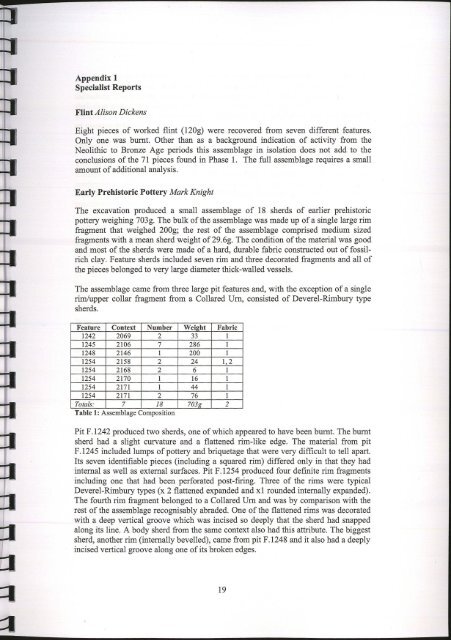Further Excavations At Langtoft. Lincolnshire www - Archaeology ...
Further Excavations At Langtoft. Lincolnshire www - Archaeology ...
Further Excavations At Langtoft. Lincolnshire www - Archaeology ...
Create successful ePaper yourself
Turn your PDF publications into a flip-book with our unique Google optimized e-Paper software.
Appendix 1<br />
Specialist Reports<br />
Flint Alison Dickens<br />
Eight pieces of worked flint (120g) were recovered from seven different features.<br />
Only one was burnt. Other than as a background indication of activity from the<br />
Neolithic to Bronze Age periods this assemblage in isolation does not add to the<br />
conclusions of the 71 pieces found in Phase 1. The full assemblage requires a small<br />
amount of additional analysis.<br />
Early Prehistoric Pottery Mark Knight<br />
The excavation produced a small assemblage of 18 sherds of earlier prehistoric<br />
pottery weighing 703 g. The bulk of the assemblage was made up of a single large rim<br />
fragment that weighed 200g; the rest of the assemblage comprised medium sized<br />
fragments with a mean sherd weight of 29.6g. The condition of the material was good<br />
and most of the sherds were made of a hard, durable fabric constructed out of fossilrich<br />
clay. Feature sherds included seven rim and three decorated fragments and all of<br />
the pieces belonged to very large diameter thick-walled vessels.<br />
The assemblage came from three large pit features and, with the exception of a single<br />
rim/upper collar fragment from a Collared Urn, consisted of Deverel-Rimbury type<br />
sherds.<br />
Feature Context Number Weight Fabric<br />
1242 2069 2 33 1<br />
1245 2106 7 286 1<br />
1248 2146 1 200 1<br />
1254 2158 2 24 1,2<br />
1254 2168 2 6 1<br />
1254 2170 1 16 1<br />
1254 2171 1 44 1<br />
1254 2171 2 76 1<br />
Totals: 7 18 703z 2<br />
Table 1: Assemblage Composition<br />
Pit F. 1242 produced two sherds, one of which appeared to have been burnt. The burnt<br />
sherd had a slight curvature and a flattened rim-like edge. The material from pit<br />
F.1245 included lumps of pottery and briquetage that were very difficult to tell apart.<br />
Its seven identifiable pieces (including a squared rim) differed only in that they had<br />
internal as well as external surfaces. Pit F.1254 produced four definite rim fragments<br />
including one that had been perforated post-firing. Three of the rims were typical<br />
Deverel-Rimbury types (x 2 flattened expanded and xl rounded internally expanded).<br />
The fourth rim fragment belonged to a Collared Urn and was by comparison with the<br />
rest of the assemblage recognisably abraded. One of the flattened rims was decorated<br />
with a deep vertical groove which was incised so deeply that the sherd had snapped<br />
along its line. A body sherd from the same context also had this attribute. The biggest<br />
sherd, another rim (internally bevelled), came from pit F.1248 and it also had a deeply<br />
incised vertical groove along one of its broken edges.<br />
19

















